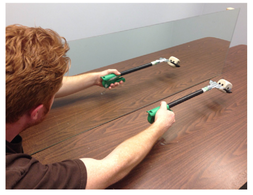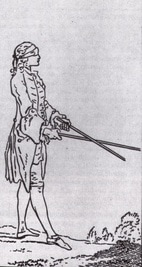Computational models of body representation
Our brains must accurately model the dimensions of our body if we are to successfully interact with the environment. For example, localizing an object touching your arm requires an internal estimate of its current state, including its current posture and dimensions (e.g., size, shape). I am interested in the neuro-computational underpinnings of these representations, with a particular focus on their role in tactile space and localization.
I have recently begun exploring the idea that the tactile localization involves multilateration, a computation that is also used by surveyors and GPS systems to localize objects on Earth. I am currently using psychophysics, computational and neural network modelling, and neuroimaging to characterize the nature of the sensorimotor system's “Body Positioning System” (BPS).
Key papers:
Our brains must accurately model the dimensions of our body if we are to successfully interact with the environment. For example, localizing an object touching your arm requires an internal estimate of its current state, including its current posture and dimensions (e.g., size, shape). I am interested in the neuro-computational underpinnings of these representations, with a particular focus on their role in tactile space and localization.
I have recently begun exploring the idea that the tactile localization involves multilateration, a computation that is also used by surveyors and GPS systems to localize objects on Earth. I am currently using psychophysics, computational and neural network modelling, and neuroimaging to characterize the nature of the sensorimotor system's “Body Positioning System” (BPS).
Key papers:
- Miller, LE., Fabio, C., van Beers, RJ., Farne, A., Medendorp, WP (2020). A neural surveyor in somatosensory cortex. bioArxiv.

9Tool use and body representation
Tools physical extend the user's body, expanding the ways that they can act on and shape their environment. Two decades of research has also found that brief use of a tool leads to measurable changes in the user's motor control and somatosensory perception, a phenomenon termed tool embodiment.
My research uses psychophysics and electrophysiology to investigate the multisensory mechanisms underlying tool embodiment in humans. To date, the majority of my work has investigated the process of embodying a tool, with a particular focus on the role of visual feedback. I have recently begun using tool embodiment as a general method for characterizing the fundamental nature of body representations themselves.
Key papers:
Tools physical extend the user's body, expanding the ways that they can act on and shape their environment. Two decades of research has also found that brief use of a tool leads to measurable changes in the user's motor control and somatosensory perception, a phenomenon termed tool embodiment.
My research uses psychophysics and electrophysiology to investigate the multisensory mechanisms underlying tool embodiment in humans. To date, the majority of my work has investigated the process of embodying a tool, with a particular focus on the role of visual feedback. I have recently begun using tool embodiment as a general method for characterizing the fundamental nature of body representations themselves.
Key papers:
- Miller, LE., Longo, MR., Saygin, AP. (2019). Tool use modulates somatosensory cortical processing. JoCN.
- Miller, LE., Longo, MR., Saygin, AP. (2017). Visual illusion of tool use recalibrates tactile perception. Cognition. 128(2): 140-48
- Miller, LE., Longo, MR., Saygin, AP. (2014). Tool morphology constrains the effects of tool use on body representations. Journal of Experimental Psychology: Human Perception and Performance. 40(6): 2143-2153.

Tools extend the sensory boundaries of your body
When using a tool to contact a surface or an object, it is common to experience touch at the tip of the tool. For example, feeling the texture of paper when writing with a pencil or the softness of the dirt when digging into the ground with a shovel. Perhaps the most striking example of this phenomenon, first described by Descartes, is the ability of the blind to navigate their environment by seeing through their walking sticks.
Above and beyond these examples, we have recently shown that rods actually function as complete sensory extensions of the body, endowing their user with perception of touch along the entirety of its surface. This ability relies on the fact that rods transduce impact location into a pre-neuronal vibratory code which is faithfully re-encoded by mechanoreceptors in the hand. Tool-extended sensing is therefore a perfect opportunity to investigated how information processing is spread across material, biomechanical and neural levels of sensory information processing. I approach this phenomenon with a wide variety of methods, including psychophysics, electrophysiology, functional MRI, and computational modeling.
Key papers:
-
- Miller, LE., Fabio, C., Ravenda, V., (...) Bolognini, N., Hayward, V., Farnè, A. (2019). Somatosensory cortex efficiently processes touch located beyond the body. Current Biology
- Miller, LE., Montroni, L., Koun, E., Salemme, R., Hayward, V., Farnè, A. (2018). Sensing with tools extends somatosensory processing beyond the body. Nature. 561(7722): 239–243
